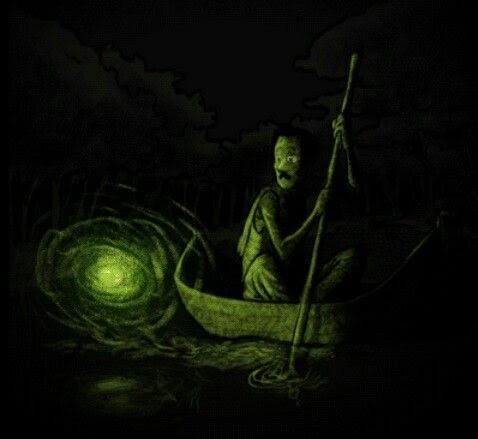It’s that time of the year again- the season for pumpkin carving, costume wearing and trick-or-treating. The tradition originated with the ancient Celtic festival of Samhain, when people would light bonfires and wear costumes to ward off ghosts. But through the course of time, Halloween has turned into the festival of chills and thrills we all know today. Whether you’re getting into the spirit of Halloween with some classic horror flicks, urban legends or creepypastas- these 10 terrors from Bengali folklore will surely bring you some chills:
Dainee (Witch)
First up, we have neither a spirit nor a ghoul. Rather, a Dainee (or Witch) is a living being- almost always a female practitioner of witchcraft and black magic. Inspiring countless books, movies and media (Hansel & Gretel anyone?), witches are no stranger to this part of the world. In Bengali lore, a witch or a Dainee is depicted as an old woman who kidnaps children, uses them for human sacrifices or drinks their blood in hopes of immortality.
Shakchunni/Petni
A Shakchunni (coming from the Sanskrit word Shankhachurni) is the unappeased spirit of a married woman- identified by the tell-tale red-white saree and Shankha (traditional conch shell bangles) that they wear. On the other hand, a Petni (otherwise called Pretni in Sanskrit) is the ghost of an unmarried woman.
Mecho bhoot & Aleya

The word Mechho comes from Maachh or ‘fish’ in Bengali. These spirits usually live near water bodies and fishing-holes. Other than stealing fishes from village houses or fishing boats, Mecho bhoots are often said to threaten and harm fishermen who refuse to give them fish. Another popular night terror among the fishermen is the Aleya or Atoshi (Will-o’-the-wisp). The phenomena of floating orbs of fire over marshlands has been observed by the fishermen of West Bengal and Bangladesh throughout the ages. Aleya have often been reported to confuse the fishermen and lure them to watery graves by calling out in irresistible voices (much like the Nishi). Local communities believe that these are the ghosts of drowned fisherman. Even now, the fishermen of Sundarbans strongly believe in the Aleya and always perform a Atoshi-taron (spirit repelling) ritual before they go fishing.
Jokkho
Much like dragons protecting mountains of gold, the Jokkho or Jokh are spirits guarding cursed treasure. According to legend, when someone with intense greed dies guarding their wealth, they are cursed to be tied to the treasure forever as a Jokh.
Skondhokata
The Bengali iteration of the famous Headless Horseman legend comes in the form of the Skondhokata. According to lore, the spirits of people who die by beheading return to the land of the living as a Skondhokata- forever cursed to search for their severed head
Begho bhoot
The word Begho comes from the Bengali word Baagh or “Tiger”. In the Sundarbans region, the locals believe Begho bhoots to be the spirits of people killed by tigers. These vengeful spirits are known to terrorize people venturing into the woods and even lure them to meet their demise at the hands of man-eating tigers.
Pishach (Ghoul) & Jol-pishach (Lake demon)
Pishach or ghouls are flesh-eating demons often found feasting on cadavers at the dead of night. These shape-shifting demons haunting graveyards or cremation grounds are notorious for infecting the minds of their victims, causing physical harm or fully possessing humans. On the other hand, like the Rusalka from Slavic lore, the Jol-pishach is a variety of demon living in lakes, rivers or ponds. Believed to be the tortured souls of drowned women with unfulfilled desires, lake demons bear the alluring appearances- with long wet hair and eyes without irises. The Jol-pishach, found in and around bodies of water (and sometimes roaming the woods), exist to lure men down under to watery graves.
Boba
The phenomenon of Sleep Paralysis is often attributed in Bengali lore to a supernatural entity called Boba (meaning unable to speak). This entity tries to strangle the victim in their sleep. The victims report themselves being unable to speak or move and often see the fearsome entity sitting over their chest as it strangles them. Though science says, a common case of sleep paralysis often results in such hallucinations, in Bangladesh, the phenomenon is called Bobaay Dhora (being struck by Boba).
Nishi
The Nishi (night spirit) is a vindictive spirit that calls out to victims in their loved one’s voices. Only striking at night, a Nishi lures away its hypnotized victims to unknown fate. Bengali lore suggests that Nishis are to be blamed for the phenomena of sleepwalking. The fear surrounding the Nishi Daak (call of the Nishi) runs deep enough to have given birth to cautionary measures like not answering a voice at night until being called at least three times- since the Nishi can only call out to its target twice.
Jinn
The Muslim community of Bengal strongly believe that any supernatural phenomenon is the work of Jinn. Jinns, who can be both good or evil are entities with undefined supernatural powers. The malevolent Jinns can not only cause hauntings in residences or abandoned locations, but also possess humans. The presence of a Jinn can be ascertained by unexplained scents, terrible odor of rotten flesh or burning odor. Popularly depicted to appear in the form of animals (commonly snake, dog, cat or crow), Jinns are known to feed on raw meat or fish. The malevolent variants of these entities can attach themselves to humans resulting in a possession- in which case the possessed is known to display the tell tale abilities of a jinn such as mind reading, extraordinary strength etc. While some Jinns are inherently benevolent- even saving humans from fatal situations, the more aggressive and vindictive Jinns are entities straight out of your nightmares.